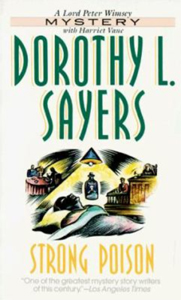Before I started reading golden-age mysteries, I thought “meta” storytelling (stories that reference the fact that they are stories, or that they exist in a familiar reality) was a more modern invention. A novel that particularly proves the concept’s old-time status is Dorothy L. Sayers’ “Strong Poison” (1930), the fifth Lord Peter Wimsey novel.
Author Harriet Vane is put on trial for the murder of her husband largely because she had purchased arsenic several times, as a way to learn about how easy it is to do so, for the sake of a mystery novel she is writing. Sayers was herself known for her intense research and strong belief that mysteries are only fair to readers if the solution is realistic.
I recently completed reading the entire Agatha Christie catalog, so I noted that her contemporary Sayers’ style differs in two notable ways, if “Strong Poison” is the evidence. First, this is a howcatchem, not a whodunit.

“Strong Poison” (1930)
Author: Dorothy L. Sayers
Genre: Mystery
Series: Lord Peter Wimsey No. 5
Setting: 1930, London
Sayers – and her rich man-of-leisure detective, Wimsey — does not actually tell us whodunit in advance. But there’s only one obvious suspect (other than Vane, who we know is innocent, because Wimsey knows it), and later, another fairly blatant clue points to this suspect. The pleasure is in how Wimsey is going to prove it.
Wimsey the delegator
And this is the second way Sayers differs from Christie. Wimsey employs several people to help him and – rather than their evidence-gathering happening off page, as would be the case with Poirot’s Mr. Goby — we often see those people in detailed action.
They include a butler, Bunter, who goes undercover; a young typist, Miss Murchison, who picks locks and distracts her boss; and a veteran typist, Miss Climpson, who poses as a medium in order to get information from a credulous nursemaid.
Miss Murchison gets lock-picking lessons from another of Wimsey’s connections. With all of his colleagues, and the respect he has from police detective Parker (who aims to marry Peter’s sister), it’s a wonder the authorities don’t release Vane simply on Wimsey’s word.
“Strong Poison” adheres to many strictures – including the legal process – but it does have a touch of whimsy, if you will, in several ways. Wimsey aims to marry Vane; in that old-fashioned style, he simply announces it to her not long after they meet for the first time. Although thoroughly confident in his detection skills, he’s flustered by romance. But it’s actually Harriet’s low self-worth he has to overcome.
Christie also used quick (by today’s standards) marriage proposals a lot, although usually on the last page, after the couple has one adventure.
Quirks and details
Sayers also likes to be true to quirky human traits. As such, Miss Climpson’s letters to Wimsey, telling of her successes as a false medium, are filled with italicized words in the way that older people used to write.
I found the Climpson and Murchison passages to be fun, but I think they could’ve landed with more of the humor Sayers was intending if they were tighter. “Strong Poison’s” weakness is that it tends toward being overwritten in the details – although it is interesting to get a peek at the London underground party scene (a surprisingly early example of the free love movement), from which Wimsey tracks down one of his expert helpers.
And if read strictly as a whodunit, it would be disappointing, as almost every reader will figure that part out. Once I realized it’s a howcatchem, I liked it more, although my enjoyment was slightly diminished because I knew a lot of Sayers’ revelations about arsenic poisoning from other golden-age mysteries.
I’ll come back for more Sayers novels, but I think I’ll pace myself rather than dosing myself with the whole catalog at once.
Sleuthing Sunday reviews the works of Agatha Christie, along with other new and old classics of the mystery genre.


